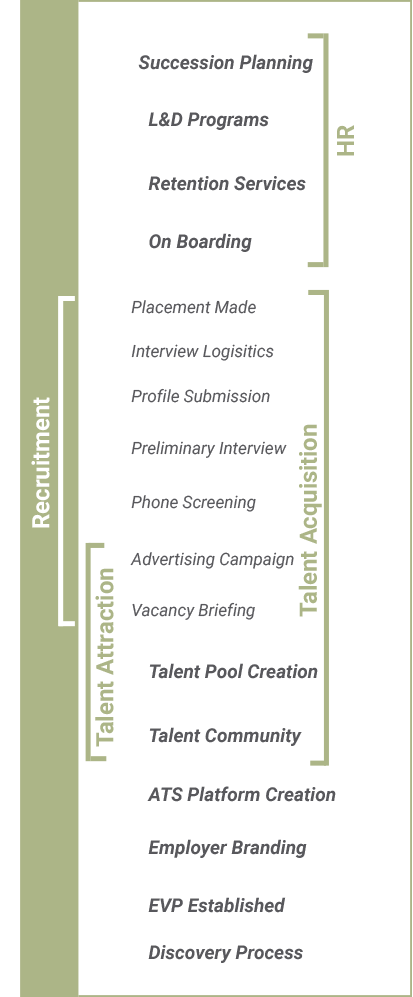People are starting to become more aware of the differences between ‘Talent Acquisition’ relative to ‘recruitment’ so of course, the industry had to muddy the waters once more. Introducing ‘Talent Attraction’ as the new kid on the block.
Let’s define things so we all have common footing just in case;
Recruitment, typically in the form of external agencies, supply specific candidates against an open requirement in a peg/hole process. In recent years this has been brought in-house with some organisations having a specialist on-site to deliver against a specific role in a very direct, outbound way. Typically though, the ‘internal recruiter’ moniker is incorrectly applied to Talent Acquisition. ‘Recruitment’ can also be seen as the function of a hiring manager following the relevant steps (however effectively) once they have a small pool gathered from other means.
Talent Acquisition is the process of broadcasting, screening, and engaging a specific group to address requirements of the organisation for immediate needs, and earmark suitable people against any likely future requirements in ‘talent pools’. The focus is to create awareness of current openings and push these active roles out to the prospective market as they arise, and wait for applicants that are systematically screened, and then introduced to hiring managers.
The Spectrum: Talent Acquisition Vs Talent Attraction Vs Recruitment

Talent Attraction is a new discipline (at least newly publicised) designed to provide a ‘behind the curtain’ approach to engaging the talent market. By providing insight into your company and the things you’re working on, and how you’re working, can draw the right talent to your company. It’s about building a reputation for your company as a great place to work, that’s doing interesting things with cool people, and then providing routes for them to approach your business, and start a conversation. When paired with ‘Recruitment’ it feeds the decision-maker with a possible candidate pool from which to drawn. This is comparable to Talent Acquisition but does require a lot more effort to maintain, and the likelihood of failure higher as the methods of candidate short-listing aren’t as likely to yield result (independentof actual performance capability) as Talent Acquisition. The up-side is that when is does work, you’ll capture candidates already engaged with your company, and therefore more likely to be outstanding performers.
While each might cover different or overlapping areas of the above spectrum, they engage and Talent Acquisition is circular, Talent Attraction is a web, and Recruitment is a linear process.
So, what option is best for your company as a start-up or running as a lean-startup? The answer is invariably a combination of at least two of the above, dependent on resources, skills, and free time within your business, or how you choose to go to market. For start-ups doing something really interesting and revolutionary, as long as you’re not compromising your IP; brag. Get out and broadcast your message. Nothing attracts a crowd like a crowd, except maybe for watercooler talk, so Talent Attraction is your best bet on a shoestring. Using social media, a blog, smoke signals – whatever – just keep it regular. Incorrect positioning can erode your Employee Value Proposition, so keep the updates in line with an overall employment strategy too. When you then need people, as long as you’ve a sensible capture mechanism (a spreadsheet can work, though far from optimal) to grab details and a few key tags for candidates, you can reach out and go through the ‘Recruitment’ piece. If you’re a little further along, perhaps a more formal and persistent Talent Acquisition strategy might work. The costs and time are considerable, both in set-up and maintenance, but it does provide a more reliable stable of candidates.
Whatever option you choose, a systematic and considered approach with the appropriate due diligence is absolutely vital. Invest the time early and stand apart from your rivals for talent.
If you wish to dig into how best to create your strategy, we can help. Schedule a time for us to talk – no sales pitch, just advice:
Leave A Comment